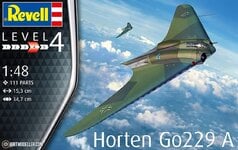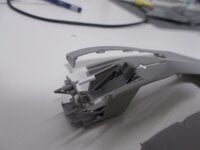tango35
Airman 1st Class
User Name: tango35
Name: Thomas
Category: Intermediate
Kit: RoG 1/48
Scale: 1/48.
Accessories: none
The Horten brothers were a pair of visionary siblings that designed a series of flying wing gliders in pre-WWII during the period when Germany was prohibited from having an air force. Each design improved on the last, and once the Luftwaffe broke cover in their expansionist phase before WWII, development began in earnest. The requirement for a light bomber capable of the 3x1000 by the RLM, which was for an aircraft capable of carrying a 1,000kg bomb load a distance of 1,000km at 1,000kph in 1943 set the wheels in motion that resulted in the Horten.IX, which is better known as the Ho.229, and sometimes referred to as the Go.229 due to the fact that the Gothaer factory had been chosen for production examples.
The flying wing had a low drag form, and the addition of two jet engines gave it the potential to fulfil the requirement, although it suffered a little from lateral instability due to its slick shape. The first prototype flew un-powered and with fixed landing gear in 1944, with results that bore plenty of promise before crashing due to a pilot error. Gotha altered the design in practical ways to ease production and increase longevity, as well as adding a rudimentary ejector seat that was probably as much of a danger to the pilot as being shot down and having to bail out. Another prototype was lost due to an engine fire, but this did not deter the RLM from striving to reach production, despite the worsening situation in Europe for Germany. The third prototype was enlarged, and it was this that fell into the hands of the advancing US troops, and subsequently the Operation Paperclip team, who took it back to America with plenty of other advanced designs. It remains there to this day, in the restoration area of the Smithsonian's NASM.
The Kit
This is a reboxing of Dragon's excellent rendition of this unusual flying wing design that inspired a number of efforts to create a flying wing design post-war, most of which weren't unduly successful with a few notable exceptions thanks to the march of technology. The kit was first seen in a Dragon box in 1992, and the moulds are wearing well, although a little flash has crept into the moulding for some of the small parts on my example, but that's the work of moments to remove. At the time, the kit was fêted for including a cockpit, gun bays and two engines in their compartments, with the option to show them off if you wished. Those aspects of the kits haven't gone away, so there's plenty of options to personalise your model from within the box. The kit arrives in an end-opening box with seven sprues of pale grey styrene, a small clear sprue, a sheet of Photo-Etch (PE), decal sheet and the instruction booklet with colour profiles on the rear pages.
Name: Thomas
Category: Intermediate
Kit: RoG 1/48
Scale: 1/48.
Accessories: none
The Horten brothers were a pair of visionary siblings that designed a series of flying wing gliders in pre-WWII during the period when Germany was prohibited from having an air force. Each design improved on the last, and once the Luftwaffe broke cover in their expansionist phase before WWII, development began in earnest. The requirement for a light bomber capable of the 3x1000 by the RLM, which was for an aircraft capable of carrying a 1,000kg bomb load a distance of 1,000km at 1,000kph in 1943 set the wheels in motion that resulted in the Horten.IX, which is better known as the Ho.229, and sometimes referred to as the Go.229 due to the fact that the Gothaer factory had been chosen for production examples.
The flying wing had a low drag form, and the addition of two jet engines gave it the potential to fulfil the requirement, although it suffered a little from lateral instability due to its slick shape. The first prototype flew un-powered and with fixed landing gear in 1944, with results that bore plenty of promise before crashing due to a pilot error. Gotha altered the design in practical ways to ease production and increase longevity, as well as adding a rudimentary ejector seat that was probably as much of a danger to the pilot as being shot down and having to bail out. Another prototype was lost due to an engine fire, but this did not deter the RLM from striving to reach production, despite the worsening situation in Europe for Germany. The third prototype was enlarged, and it was this that fell into the hands of the advancing US troops, and subsequently the Operation Paperclip team, who took it back to America with plenty of other advanced designs. It remains there to this day, in the restoration area of the Smithsonian's NASM.
The Kit
This is a reboxing of Dragon's excellent rendition of this unusual flying wing design that inspired a number of efforts to create a flying wing design post-war, most of which weren't unduly successful with a few notable exceptions thanks to the march of technology. The kit was first seen in a Dragon box in 1992, and the moulds are wearing well, although a little flash has crept into the moulding for some of the small parts on my example, but that's the work of moments to remove. At the time, the kit was fêted for including a cockpit, gun bays and two engines in their compartments, with the option to show them off if you wished. Those aspects of the kits haven't gone away, so there's plenty of options to personalise your model from within the box. The kit arrives in an end-opening box with seven sprues of pale grey styrene, a small clear sprue, a sheet of Photo-Etch (PE), decal sheet and the instruction booklet with colour profiles on the rear pages.
Attachments
Last edited:





